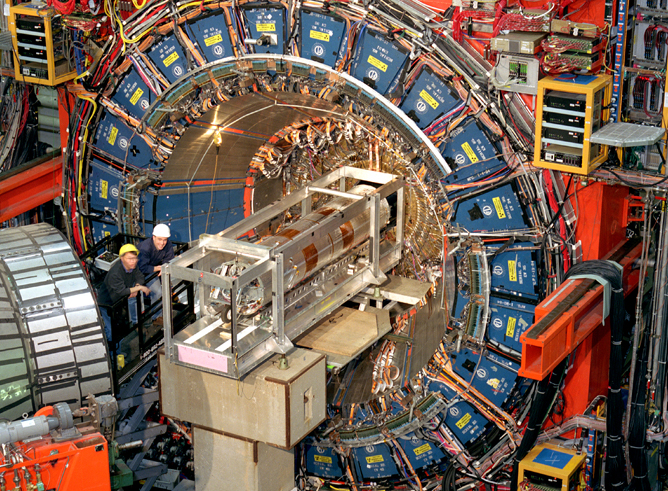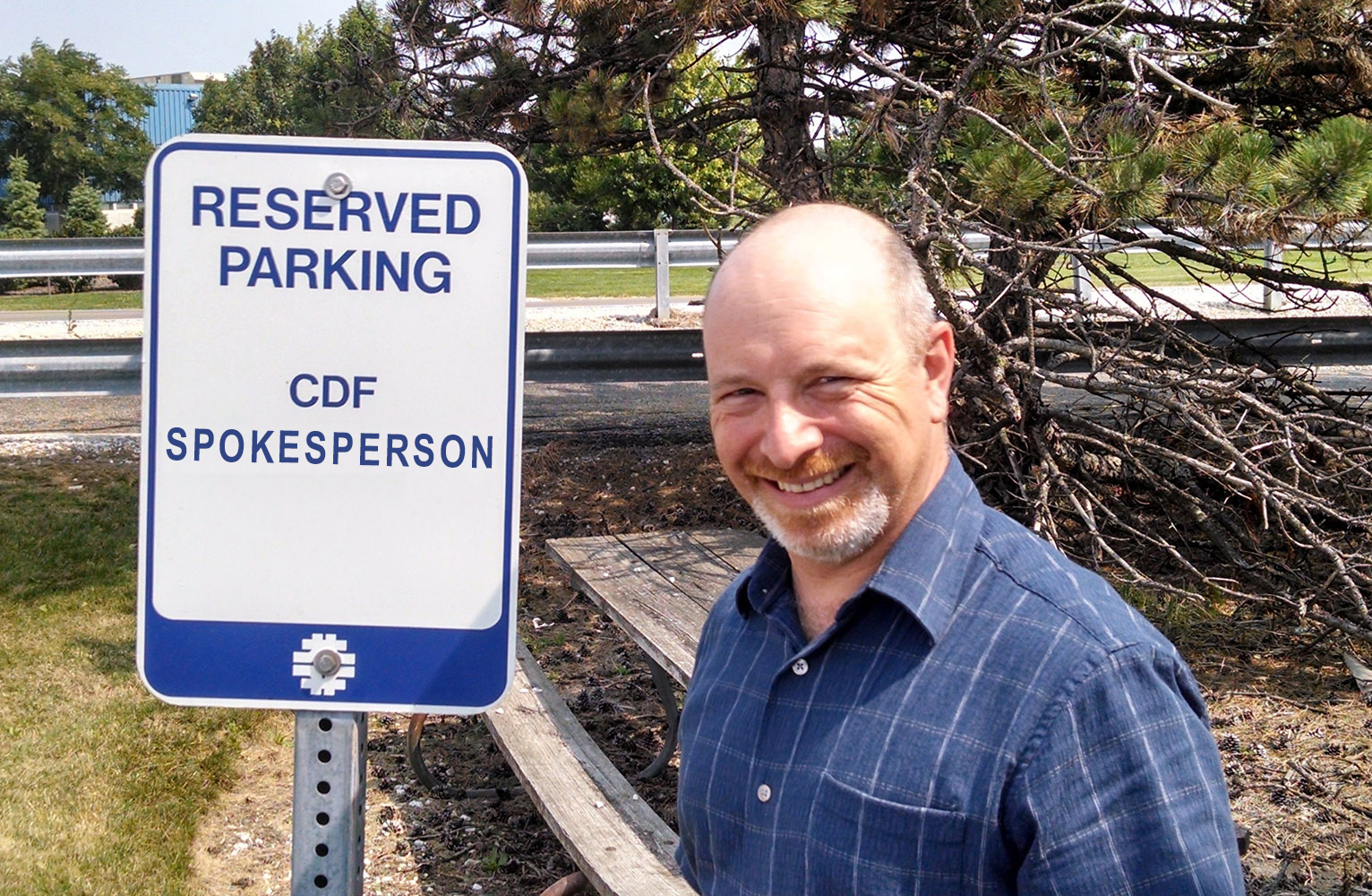
When Texas A&M University physicist David Toback was elected eight years ago as co-spokesperson and overall physics coordinator for the CDF collaboration at the U.S. Department of Energy’s Fermi National Accelerator Laboratory (Fermilab), he had one primary goal: to help the group’s 400-person active author list publish the collaboration’s important legacy papers and final results.
Although the Collider Detector at Fermilab experiment representing 54 institutions across 23 countries stopped collecting new data three years before Toback assumed his leadership role on June 1, 2014, he says its impact lives on in its analysis, none bigger than that which graces the cover of the current issue of Science announcing the most precise measurement to date of the mass of the W boson, one of nature’s force-carrying particles responsible for the nuclear processes that make the sun shine and particles decay.
Using high-energy particle collisions produced by the Tevatron collider at Fermilab, the CDF collaboration collected huge amounts of data containing W bosons from 1985 to 2011. Following 10 years of careful analysis and scrutiny of that data, CDF-affiliated scientists led by Duke University’s Ashutosh V. Kotwal and the University of Oxford’s Chris Hays have now determined the particle’s mass with a precision of 0.01% — twice as precise as the previous best measurement. The achievement corresponds to measuring the weight of an 800-pound gorilla to within 1.5 ounces.
The new precision measurement allows scientists to test the Standard Model of particle physics, the theoretical framework that describes nature at its most fundamental level. The result: The new mass value shows significant tension with the value scientists expect to obtain using experimental and theoretical inputs in the context of the Standard Model.
“The Standard Model is one of the crowning achievements in human history,” Toback said. “It predicted the existence of the W and Z bosons as well as the Higgs boson, all of which have been discovered, but it goes way beyond that in that it makes remarkably precise predictions for what the mass of the W boson should be. However, we’ve always known the Standard Model isn’t complete. It doesn’t explain gravity or dark matter. Something has to be missing. Therefore, we’ve been searching for ‘cracks’ in the Standard Model for decades to provide a clue to point the way. This measurement, which represents more than a decade of concerted effort, may be one of the most highly scrutinized in CDF history.”

Toback, a high-energy physics expert and veteran researcher in several related international collaborations, has been a faculty member in the Texas A&M Department of Physics and Astronomy since 2000, where he is the Thaman Professor for Undergraduate Teaching Excellence and a member of the George P. and Cynthia Woods Mitchell Institute for Fundamental Physics and Astronomy. He began working with the Collider Detector at Fermilab collaboration in 1991 as a graduate student at the University of Chicago and has served as co-convener of CDF’s Top + Beyond the Standard Model Group while also guiding the Supersymmetry Group. In 2015, he was elected as a fellow of the American Physical Society on the basis of his CDF experiment leadership and pioneering work on related searches for new particles
Toback describes the CDF collaboration’s latest result is an important contribution to testing the accuracy of the Standard Model, which may need to be improved or extended in the event the measurement is confirmed.
“It’s now up to the theoretical physics community and other experiments to follow up on this and shed light on this mystery,” he added. “If the difference between the experimental and expected value is due to some kind of new particle or subatomic interaction, which is one of the possibilities, there’s a good chance it’s something that could be discovered in future experiments.”
Fermilab’s Tevatron and CERN’s Large Hadron Collider (LHC) are the past and current record holders, respectively, for the most powerful particle colliders on Earth. After 26 years of colliding particles, the Tevatron shut down on September 29, 2011, with the completion of the LHC. However, because it observed collisions between protons and antiprotons via its two detectors — the three-story, 6,000-ton CDF, along with its companion DZero — physicists widely agree the Tevatron produced groundbreaking fundamental results, few more intriguing than this one.
“Deviations from the Standard Model are extremely rare,” said Grigory V. Rogachev, professor and head of Texas A&M Physics and Astronomy. “There may be just a single credible one — for instance, a magnetic moment of a muon — but even that is highly suspect due to difficulties in theoretical analysis. It appears that deviation of W boson mass from the Standard Model prediction may become a central piece in particle physics for years to come.”
“This is certainly a very challenging and rewarding measurement,” added Bhaskar Dutta, Texas A&M theoretical physicist and managing director of the Mitchell Institute. “It opens up the floor for many new ideas.”

Toback is quick to point out that Texas A&M’s history with the CDF experiment is far more extensive than his involvement, given that it was co-founded in 1980 in part by Texas A&M physicists Peter McIntyre and Robert Webb. Texas A&M has had a continuous presence in the collaboration since its inception, including four additional physicists — Toback, Ricardo Eusebi, Teruki Kamon and Alexei Safonov — who either were students or postdoctoral researchers within it and are now among its principal investigators. Kamon produced the collaboration’s fourth Ph.D. thesis, followed by Toback (159th, 1997), Safonov (242nd, 2001) and Eusebi (345th, 2005). All four played lead roles in Tevatron Run II, with Toback leading the team that built the timing system for the CDF electromagnetic calorimeter.
Beyond faculty contributions, Toback notes that dozens of Texas A&M students have earned Ph.D.s based on CDF-related work, while many more have achieved master’s degrees and/or did honors undergraduate thesis-related work with CDF. In addition, many within this collective CDF-inspired whole have gone on to faculty positions, including at Texas A&M and other prestigious research universities worldwide.
The collaboration’s prior crowning achievements include discovery of the top quark in 1995, insights into the production rate of charm quarks in 2017, and detection of the first substantive evidence of the Higgs boson prior to the Large Hadron Collider’s 2012 full discovery that collectively resulted in Peter Higgs’ and Francois Englert’s subsequent 2013 Nobel Prize in Physics for theoretically predicting the elusive particle’s existence 50 years ago.
In addition to CDF, Toback serves as a co-principal investigator for the international Super Cryogenic Dark Matter Search (SuperCDMS) experiment and works in the areas of neutrino physics (DUNE R&D), quantum computing and big computing. His past work includes the DZero experiment at Fermilab and the CMS Experiment at the LHC.
“CDF is in the business of reporting the facts as we know them,” Toback said. “We take that role very seriously. We take this small but clear difference from the Standard Model very seriously. It might, just might, be the clue we need to crack open the case.
“This has been an exciting adventure — an honor and a privilege of the highest degree. I am grateful to the Texas A&M Department of Physics and Astronomy, the Mitchell Institute, and my CDF community colleagues for the continued opportunity to serve the CDF collaboration.”
See today’s complete announcement from Fermilab.
To learn more about CDF, visit https://cdf.fnal.gov.
For more information on Toback’s broader research, visit http://tobackgroup.physics.tamu.edu/.
Interested in additional background about the actual research? Check out this Duke Today feature on lead CDF collaboration researcher and Duke physicist Ashutosh V. Kotwal.
# # # # # # # # # #
About Research at Texas A&M University: As one of the world’s leading research institutions, Texas A&M is at the forefront in making significant contributions to scholarship and discovery, including in science and technology. Research conducted at Texas A&M generated annual expenditures of more than $1.13 billion in fiscal year 2020 and ranked 14th in the National Science Foundation’s Higher Education Research and Development Survey. Texas A&M’s research creates new knowledge that provides basic, fundamental and applied contributions resulting, in many cases, in economic benefits to the state, nation and world. To learn more, visit Research@Texas A&M.
Did You Know
The CDF W boson result was honored as one of the best and biggest physics breakthroughs of 2022 by multiple outlets, including Live Science, Cosmos Magazine and NPR. According to the Fermilab Office of Communications, news of the groundbreaking finding as initially reported in Science garnered 830 media mentions during the week of April 6-11, 2022, reaching a potential audience in excess of 1.6 billion.
